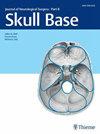海绵窦血管瘤单次伽玛刀放射手术后的临床和放射学反应
IF 0.9
4区 医学
Q3 Medicine
引用次数: 0
摘要
目的:海绵窦血管瘤(CSH)占海绵窦病变的 2-3%。海绵窦血管瘤的最佳治疗策略尚未确定,包括单独或联合使用显微外科切除术和放射外科手术。因此,我们旨在分析伽玛刀放射手术(GKRS)对原发性和残余 CSH 的疗效和安全性。方法:对2012年至2021年间接受单次伽玛刀放射外科治疗的33例CSH患者(26例原发性CSH和7例残余CSH)进行回顾性分析。获得了人口统计学、临床、放射学和随访数据,并评估了GKRS术后的临床和放射学反应。结果:组群的平均年龄为4313.5岁(10-77岁)。男性9人(27.3%),女性24人(72.7%)。病灶体积中位数为6.9cc,范围在1.46至19.06cc之间。肿瘤边缘的平均剂量为13.501.5Gy(范围为12至15Gy)。临床随访的中位时间为 41 个月,在此期间,肿瘤体积平均缩小了 87.6%。23名患者(69.7%)出现了完全反应,即随访影像中没有肿瘤。23 名患者(69.7%)在接受 GKRS 后临床症状有所改善。没有放射引起的并发症。结论:CSH 具有独特的放射学外观,对放射外科手术的反应可预测。当主要用于经放射学诊断的 CSH 并作为次全切除术的辅助治疗时,GKRS 可产生较高的体积缩小率,同时改善神经功能,并将颅神经的发病率降至最低。因此,GKRS 是一种可行的手术替代疗法,而不会产生与手术切除相关的发病率。本文章由计算机程序翻译,如有差异,请以英文原文为准。
Clinical and Radiological Response following Single-Session Gamma Knife Radiosurgery in Cavernous Sinus Hemangiomas.
Purpose: Cavernous sinus hemangiomas (CSH) represent 2-3% of lesions occupying the cavernous sinus. The optimal management strategy for CSH in not established, with microsurgical resection and radiosurgery employed alone or in combination. Therefore, we aimed to analyse the efficacy and safety of Gamma Knife Radiosurgery(GKRS) for CSH in a cohort of primary and residual CSH.
Methods: A retrospective analysis of 33 patients(26 primary and 7 residual CSH) that underwent single-session GKRS between 2012 and 2021 for CSH was performed. Demographic, clinical, radiological and follow-up data were acquired, and clinicoradiological response following GKRS was assessed.
Results: The mean age of the cohort was 4313.5 years(range 10–77). There were 9 males (27.3%) and 24 females(72.7%). The median lesion volume was 6.9cc, ranging 1.46 to 19.06cc. The mean dose administered to the tumor margin was 13.501.5Gy(Range 12 to 15Gy). The median duration of clinical follow-up was 41 months, over which period the mean reduction in tumor volume was 87.6%. Complete response, defined as absence of tumor on follow-up imaging occurred in 23 patients(69.7%). Twenty-three patients(69.7%) showed clinical improvement following GKRS. There were no radiation-induced complications.
Conclusions: CSH have a distinct radiological appearance and a predictable response to radiosurgery. When used primarily in radiologically diagnosed CSH and as adjunctive therapy supplementing a subtotal excision, GKRS produces a high rate of volume reduction with improvement of neurological function and minimal cranial nerve morbidity. Therefore, GKRS presents a viable alternative to surgery without the morbidity associated with surgical resection.
求助全文
通过发布文献求助,成功后即可免费获取论文全文。
去求助
来源期刊

Journal of Neurological Surgery Part B: Skull Base
CLINICAL NEUROLOGY-SURGERY
CiteScore
2.20
自引率
0.00%
发文量
516
期刊介绍:
The Journal of Neurological Surgery Part B: Skull Base (JNLS B) is a major publication from the world''s leading publisher in neurosurgery. JNLS B currently serves as the official organ of several national and international neurosurgery and skull base societies.
JNLS B is a peer-reviewed journal publishing original research, review articles, and technical notes covering all aspects of neurological surgery. The focus of JNLS B includes microsurgery as well as the latest minimally invasive techniques, such as stereotactic-guided surgery, endoscopy, and endovascular procedures. JNLS B is devoted to the techniques and procedures of skull base surgery.
 求助内容:
求助内容: 应助结果提醒方式:
应助结果提醒方式:


